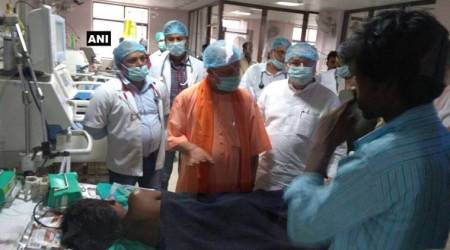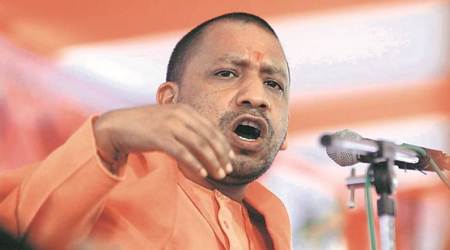 At a protest over the Gorakhpur tragedy in Delhi. Prem Nath Pandey
At a protest over the Gorakhpur tragedy in Delhi. Prem Nath Pandey
GORAKHPUR’S BRD Medical College Hospital has patients 10 times its admission capacity, especially in the neonatal unit, according to a central team that visited the tertiary health facility on Saturday. This has raised questions on special newborn care units or SNCUs in the district and nearby areas, which are meant to play a critical role in saving lives. Fourteen years after a small UNICEF funded project in West Bengal’s Purulia district showed the effectiveness of SNCUs in reducing infant mortality and 12 years after that model was adopted under the then National Rural Health Mission for replication across the country, non-functional SNCUs have left the BRD Hospital grappling with a grinding patient load.
When the team visited the hospital on Saturday, they saw every infant warmer — used for babies suffering from low body temperature — was shared by three-four infants. Ideally, one such machine should be used for one infant.
Sources said that despite a government scheme under the National Health Mission for constructing SNCUs in every district to ease pressure on tertiary-care hospitals, SNCUs in districts such as Basti and Ballia that are close to Gorakhpur have meant that BRD continues to tackle an enormous patient load.
“The SNCUs in the surrounding districts such as Basti and Ballia are either non-existent or non-functional. There is an SNCU in Ballia, yet babies are referred to BRD hospital by the staff who probably prefer to leave early. Admitting critical patients would mean staying in the unit round the clock,” said a source who was at BRD Hospital with the central team. Around 2,000-2,500 patients come to the 200-bed BRD hospital every day.
An SNCU is generally a 12-20-bed unit and requires four doctors and 10-12 nurses for round-the-clock treatment of sick newborns. The cost of setting up an SNCU is about Rs 41 lakh and the operational cost around Rs 10 lakh
per annum. A government statement dated July 28, 2017, said 700 SNCUs were functional across the country to provide 24/7 care. “The problem is in monitoring the quality of care at these units. If sick babies continue to be referred to a tertiary care hospital, despite SNCUs having been set up, it defeats the very purpose (of setting them up). There is, as reported, a problem with the oxygen supply in BRD Hospital. It is working with standby oxygen cylinders. But the real issue is overcrowding,” the source said.
Union Health Minister J P Nadda, Minister of State for health Anupriya Patel and health secretary C K Mishra headed to Gorakhpur on Sunday and announced the setting up of a regional medical centre for Rs 85 crore in Gorakhpur for in-depth research on children’s diseases. A separate team of doctors and officials from Delhi went to the hospital on Sunday. The team, which had Sushma Nangia, head of the neo-natal unit at Lady Hardinge Medical College, M K Agarwal, deputy commissioner (immunisation), and Harish Chillani, head of the paediatric department at Safdarjung Hospital, said they were analysing the data given by the BRD Hospital.
Dr Nangia said: “What we must understand is that newborns are coming from far-off districts in an unstable condition. Some of the deaths took place within 24 hours.” She said the need was to “also strengthen primary and secondary care facilities and also sensitise the parents”.
Dr Agarwal said while they had not found any “abnormality” in the death rate as compared to the same period in past years, the team would recommend a “death audit review” to the government.

